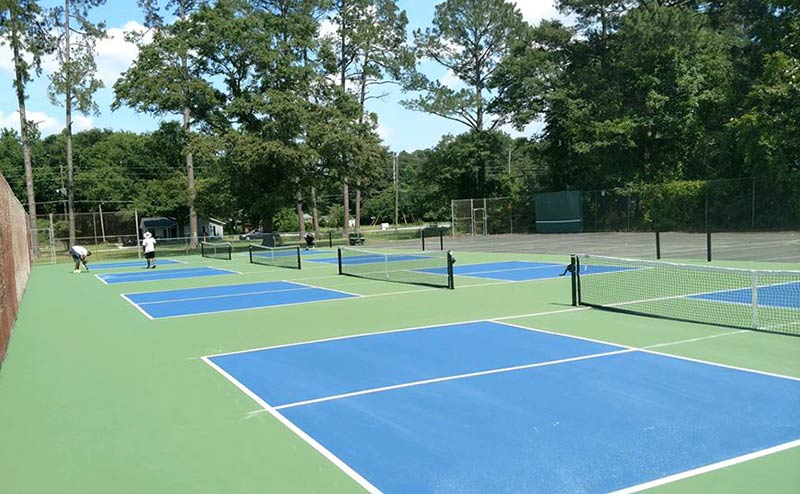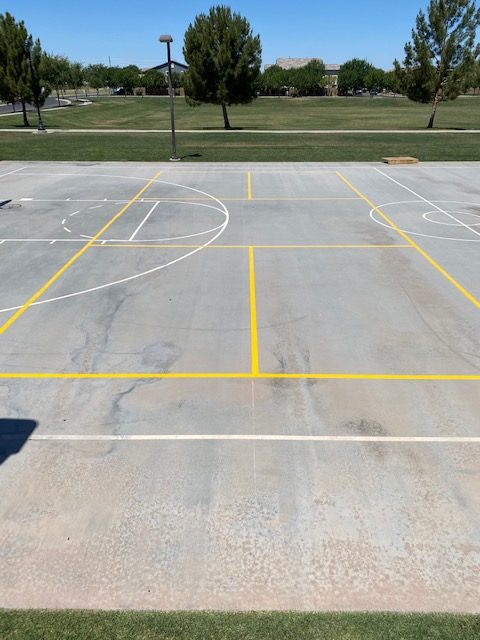A Comprehensive Overview to Designing the Perfect Pickleball Court for All Ability Levels
Designing a pickleball court that caters to players of varying skill levels necessitates a multifaceted approach, incorporating important aspects such as court measurements, surface area products, and access attributes. What certain factors to consider must be focused on to guarantee a successful application?

Understanding Court Dimensions
Recognizing the measurements of a pickleball court is critical for both designers and players, as these specs guarantee a reasonable and consistent having fun experience. A common pickleball court measures 20 feet large by 44 feet long for both singles and increases play. The court is split into 2 equal halves by a web that stands 36 inches high at the sidelines and 34 inches at the center.
Trick functions of the court include the non-volley area, commonly referred to as the "cooking area," which extends 7 feet from the web on both sides. This location is important for managing gamer motion and volleying, ensuring calculated play. Furthermore, the service areas on each side of the court are essential, determining 10 feet large and 15 feet deep, designed to accommodate appropriate serving methods.
Bordering the court, a location of at the very least 10 feet ought to be assigned as the safety and security area, enabling players adequate room to relocate and protect against injuries during play. Adhering to these dimensions not just fosters reasonable competitors but also advertises security and satisfaction for all individuals, making it important for any kind of pickleball court design.
Selecting the Right Surface Area
The selection of playing surface for a pickleball court dramatically affects the game's dynamics and player experience. Choosing the proper product is critical for making certain gamer safety and security, comfort, and performance. Common surface areas include asphalt, concrete, and specialized sports flooring.
Asphalt is a prominent option because of its affordability and sturdiness. It offers a consistent having fun surface but can be tough on joints over expanded play. Concrete, while similar in sturdiness, offers marginal flexibility, possibly resulting in increased influence on gamers' bodies.
For an extra supported experience, several centers select customized sports flooring, such as modular floor tiles or artificial surfaces. These products often consist of shock-absorbing properties, decreasing the danger of injuries and boosting player comfort. Moreover, such surfaces can improve ball bounce consistency, which is important for fair play.
When picking a surface area, think about aspects such as climate, maintenance demands, and the strength of play. A well-chosen surface not only enhances gameplay but also adds to the longevity of the court itself. Ultimately, understanding the subtleties of various products will help in developing an optimum pickleball atmosphere tailored to different skill degrees.
Optimal Court Design
An ideal court design is essential for making best use of both gamer performance and viewer pleasure in pickleball. The measurements of a basic pickleball court are 20 feet broad by 44 feet long for doubles play, maintaining a clear boundary that improves gameplay. The web, placed at 36 inches high at the sidelines and 34 inches in the center, is crucial for keeping the dynamics of the game.
Including assigned locations around the court for players to relocate openly is vital. A minimum of 10 feet of clearance on all sides of the court is suggested to avoid accidents and give room for viewers. Additionally, alignment plays a substantial duty; the court needs to preferably be lined up north-south to minimize the impact of sun glow on gamers during height hours.
Effective spectator positioning is equally vital. Elevated seeing bleachers or locations positioned behind the sidelines can improve the experience while ensuring safety. Finally, clear and noticeable court markings aid in gameplay, with contrasting shades for limits and non-volley areas that mark critical locations for players. Generally, a properly designed court layout fosters an appealing setting for both spectators and gamers.

Accessibility Considerations
When why not check here creating a pickleball court, making certain availability for all gamers, consisting of those with handicaps, is critical. A thoughtfully created court can promote inclusivity and urge involvement from people of varying capabilities.

Accessibility courses to the court have to additionally be carefully planned. Make certain that paths bring about the court are vast sufficient for mobility device individuals and are furnished with ramps where needed. Signs must be clear and huge enough to be easily read.
Moreover, seating locations must be created to enable easy access to and from the court. This consists of providing assigned rooms for viewers who may have movement challenges.
Last but not least, make certain that bathroom facilities close-by satisfy accessibility standards. By considering these components, you can develop a pickleball court that is inviting and usable for every person, thus advertising a diverse and vibrant area of players.
Upkeep and Maintenance
Appropriate upkeep and upkeep click to investigate of a pickleball court are necessary for guaranteeing ideal having fun problems and prolonging the life-span of the center. Regular evaluations must be performed to recognize and address any type of problems or wear, such as cracks in the surface area or loosened netting. These problems, if left ignored, can negatively affect gameplay and security.
Surface maintenance is critical; courts must be cleaned frequently to remove debris, leaves, or dirt that can impact traction. For difficult courts, regular pressure washing is suggested to maintain surface area honesty and aesthetic appeals. If your court is made from softer materials, such as asphalt, resurfacing or sealing may be necessary to protect against weather-related wear.
In addition, internet elevation and tension should be checked routinely, as improper setups can change gameplay. Maintaining bordering areas, including secure fencing and illumination, is equally important for making certain a delightful and risk-free environment.
Verdict
In final thought, the style of an excellent pickleball court necessitates a meticulous approach that encompasses correct measurements, ideal surface area materials, and thoughtful design. By adhering to these guidelines, the ideal pickleball court can be created, promoting satisfaction and sports advancement for players of differing skill levels.
Creating a pickleball court that caters to gamers of differing ability levels demands a complex technique, including important aspects such as court dimensions, surface area products, and ease of access features.Recognizing the dimensions of a pickleball court is important for both developers and players, as these requirements make certain a reasonable and regular having fun experience.The option of playing surface area for a pickleball court dramatically influences the video game's dynamics and player experience.An optimal court design is essential for making best use of both gamer performance and viewer enjoyment in pickleball. By sticking to these standards, the ideal pickleball court can be created, advertising satisfaction and athletic advancement for players of varying skill degrees.